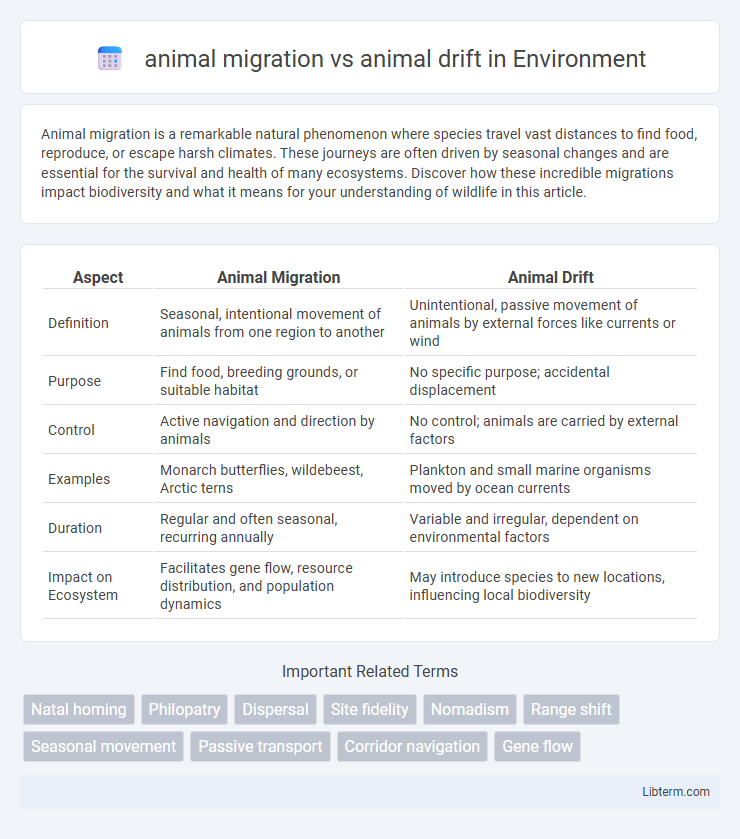Animal migration is a remarkable natural phenomenon where species travel vast distances to find food, reproduce, or escape harsh climates. These journeys are often driven by seasonal changes and are essential for the survival and health of many ecosystems. Discover how these incredible migrations impact biodiversity and what it means for your understanding of wildlife in this article.
Table of Comparison
| Aspect | Animal Migration | Animal Drift |
|---|---|---|
| Definition | Seasonal, intentional movement of animals from one region to another | Unintentional, passive movement of animals by external forces like currents or wind |
| Purpose | Find food, breeding grounds, or suitable habitat | No specific purpose; accidental displacement |
| Control | Active navigation and direction by animals | No control; animals are carried by external factors |
| Examples | Monarch butterflies, wildebeest, Arctic terns | Plankton and small marine organisms moved by ocean currents |
| Duration | Regular and often seasonal, recurring annually | Variable and irregular, dependent on environmental factors |
| Impact on Ecosystem | Facilitates gene flow, resource distribution, and population dynamics | May introduce species to new locations, influencing local biodiversity |
Understanding Animal Migration: Purposeful Movement
Animal migration involves purposeful, seasonal movement driven by survival needs such as breeding, feeding, and climate adaptation, distinguishing it from animal drift, which is passive and influenced by environmental forces like currents or wind. Migratory species like monarch butterflies and Arctic terns navigate long distances with innate biological mechanisms, optimizing energy use and increasing reproductive success. This intentional relocation contrasts sharply with drift events, where animals are transported unintentionally without behavioral control.
Defining Animal Drift: Random Dispersal Explained
Animal drift refers to the random, passive movement of animals carried by environmental forces such as water currents or wind, unlike purposeful animal migration driven by innate behavioral cues. This unintentional dispersal often results in individuals being transported to new habitats without active navigation or destination selection. Understanding animal drift is crucial for studying species distribution patterns and the genetic flow within populations influenced by stochastic environmental factors.
Key Differences Between Migration and Drift
Animal migration involves deliberate, seasonal movement between habitats driven by factors like breeding or food availability, often covering long distances with a predictable pattern. In contrast, animal drift refers to passive, uncontrollable displacement influenced by external forces such as ocean currents or wind, lacking purposeful navigation. Migration reflects adaptive behavioral strategies, whereas drift results from environmental conditions impacting animal location.
Evolutionary Advantages of Animal Migration
Animal migration provides significant evolutionary advantages by enabling species to exploit seasonal resources, avoid predators, and find optimal breeding grounds, which enhances survival and reproductive success. This long-distance movement allows genetic diversity through population mixing, increasing resilience to environmental changes. Unlike animal drift, which is typically passive and unplanned, migration is a strategic, energy-intensive behavior shaped by natural selection to maximize fitness.
Ecological Impact of Animal Drift
Animal drift, characterized by the passive movement of organisms due to environmental forces like currents or wind, significantly influences ecosystem dynamics by redistributing species and genetic material across habitats. This process can alter community structures, promote gene flow, and enhance species resilience to environmental changes, contrasting with active migration that involves directed movement for breeding or resource access. Understanding animal drift's ecological impact is crucial for managing biodiversity, predicting dispersal patterns, and conserving connected aquatic and terrestrial ecosystems.
Navigation Mechanisms: Migration vs Drift
Animal migration relies heavily on advanced navigation mechanisms such as geomagnetic orientation, celestial cues, and olfactory signals to ensure precise, long-distance travel between habitats. In contrast, animal drift depends largely on passive movement influenced by external factors like ocean currents, wind patterns, or river flow, with minimal active navigation control. Migration allows species to exploit seasonal resources through intentional routes, whereas drift results in unintended displacement shaped by environmental forces.
Examples of Migratory Species
Monarch butterflies exemplify long-distance animal migration, traveling thousands of miles between North America and central Mexico to exploit seasonal resources. Similarly, the Arctic tern undertakes one of the longest migratory journeys, flying from its Arctic breeding grounds to Antarctic wintering areas annually. In contrast, animal drift refers to passive movement influenced by environmental forces, seen in plankton and some fish larvae transported by ocean currents rather than active navigational migration.
Instances of Animal Drift in Nature
Animal drift refers to the passive movement of organisms caused by external forces such as water currents, wind, or tides rather than active movement like animal migration, which involves purposeful travel to find resources or mate. Instances of animal drift are common in marine ecosystems, where zooplankton, larvae of fish, and coral spawn are transported by oceanic currents across vast distances. River systems also showcase animal drift with drifting aquatic insects and fish eggs carried downstream, playing a crucial role in dispersal and population dynamics.
Human Influences on Migration and Drift Patterns
Human activities such as urbanization, deforestation, and climate change significantly disrupt animal migration routes and drift patterns by altering habitats and environmental cues. Pollution and artificial light can disorient migrating species, leading to increased mortality and reduced reproductive success. Conservation efforts must integrate habitat preservation and mitigate anthropogenic barriers to sustain natural migration and drift behaviors.
Conservation Challenges: Protecting Migratory and Drifting Species
Conservation efforts face significant challenges due to the differing behaviors of animal migration and animal drift, requiring tailored strategies to protect species that traverse vast distances versus those passively moved by currents. Migratory species demand protection of diverse habitats along their routes to ensure safe passage and breeding grounds, while drifting species need conservation of critical oceanic zones that sustain life during passive transport. Habitat fragmentation, climate change, and human activities exacerbate risks for both groups, necessitating integrated policies that address the full spectrum of movement patterns in wildlife conservation.
animal migration Infographic

 libterm.com
libterm.com